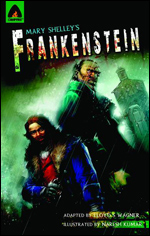Frankenstein: Campfire Edition
 Frankenstein
Frankenstein
Written by: Mary Shelley, adapted by Lloyd Wagner
Illustrated by: Naresh Kumar
Publisher: Campfire
Format: Softcover, 6 x 9, 72 pages, Full Color, $9.99
ISBN: 978-9-38002-824-8
Mary Shelley's Frankenstein is one of my all-time favorite novels. So, when I was contacted by Campfire publishers to see if I would be interested in reviewing one of their new graphic novel adaptations, which just so happened to be Frankenstein, my interest was more than piqued. Destined to be a meticulous critic of an adaptation of one of my favorite novels I waited for it to arrive in the mail. From the moment I picked it up, I liked it.
First of all, it reminded me of some of the high-quality graphic novel adaptations I reviewed earlier this year, most notably Marvel's Pride and Prejudice and Dynamite's Sherlock Holmes. Like Marvel's and Dynamite's graphic novel adaptations, Campfire has paid close attention to authenticity and to detail.
Campfire's Frankenstein is authentically respectful of Mary Shelley's original 1818 version of the novel.* Second, and this took me by surprise, this thin graphic novel adaptation is detail-oriented. All of the major plot events, characters, and narratives are present. Beginning with Walton's frame-story narrative of Victor Frankenstein's rescue from a near-freezing, polar death, and Frankenstein's telling of his own story within a story, this graphic novel adaptation paces itself as Shelley paced the 1818 version of the novel. And, with Dr. Frankenstein narrating this seemingly-surreal but true tale to Walton, readers are introduced not only to all the main characters, but also to their fates: Caroline Frankenstein, Alphonse Frankenstein, Elizabeth Frankenstein, William Frankenstein, Henry Clerval, the creature, and, finally, Walton.
For teachers looking for a thoughtful graphic novel adaptation of Mary Shelley's Frankenstein Campfire's version gets a strong stamp of approval.
* Following the death of her husband, Percy Bysshe Shelley, Mary Shelley also published an 1831 version of the text.
English Language Arts Elements of Story
Plot: A passionate young scientist fascinated with anatomy and physiology, Dr. Victor Frankenstein is traveling on dogsled over frozen waters. Finding him near death, some sailors try to convince the young Doctor to save his life and restore himself on board their vessel. After a lengthy recovery, Frankenstein tells his tale of creation, misery, and pursuit to the leader of these men, Walton.
Setting: Northern, frozen ice; Geneva; England and Scotland; Ingolstadt; Swiss Alps
Characters: Walton, Dr. Victor Frankenstein, Caroline Frankenstein, Alphonse Frankenstein, Elizabeth Frankenstein, William Frankenstein, Henry Clerval, the creature
Themes: Family, Identity, Creationism, Revenge, Passion, Pursuit
Traditional Literature Pairing Suggestions:
- Either Mary Shelley's 1818 or 1831 version on Frankenstein
- The Book of Genesis
- Charles Dickens' Great Expectations or David Copperfield
- Moby Dick by Hermann Melville
- Native Son by Richard Wright
- Invisible Man by Ralph Ellison
- The Hunchback of Notre Dame by Victor Hugo
Some Teaching Recommendations For Middle School & High School English Language Arts
Suggested Alignment to the IRA /NCTE Standard(s):*
- standard #s correspond to the numbers used by IRA/NCTE
1. Students read a wide range of print and nonprint texts to build an understanding of texts, of themselves, and of the cultures of the United States and the world; to acquire new information; to respond to the needs and demands of society and the workplace; and for personal fulfillment. Among these texts are fiction and nonfiction, classic and contemporary works.
2. Students read a wide range of literature from many periods in many genres to build an understanding of the many dimensions (e.g., philosophical, ethical, aesthetic) of human experience.
3. Students apply a wide range of strategies to comprehend, interpret, evaluate and appreciate texts.
4. Students employ a wide range of strategies as they write and use different writing process elements appropriately to communicate with different audiences for a variety of purposes.
Suggested Guided Reading Lesson Plan:
Before Reading
Sine this story is probably familiar to most students it may be wise to begin with a KWL chart (Ogle, 1986). Drawing this three-column chart on the board (while also offering students a KWL chart handout), teachers can first ask students what they Know about Frankenstein? And, second, what they Wonder about Frankenstein?
During Reading
As they read students can then fill out the Learn category. What, after students read each section, have they learned about Frankenstein?
After Reading
In alignment with the above-mentioned IRA/NCTE standards, the KWL reading strategy can then move students from a focus on reading to a focus on writing. Reflecting back on their reading and KWL charts, students can be asked to write their own comic book, Frankenstein inspired, stories from the perspectives of characters who are not given their own narratives in the text.
NOTE: To find graphic novel panels and gutters students can use to write these new perspective stories, teachers can perform a simple Google image search for "comic book panels and gutters."
Sources:
NCTE/IRA. (1996). Standards for the English Language Arts. Urbana, IL: NCTE.
Ogle, D. (1986). KWL: A teaching model that develops active reading of expository Text. The Reading Teacher 32, 564-570.
Katie Monnin, PhD, is an assistant professor of literacy at the University of North Florida and author of Teaching Graphic Novels: Practical Strategies for the Secondary ELA Classroom (2010) from Maupin House. To learn more about Teaching Graphic Novels or Katie Monnin, please go to this link: http://www.maupinhouse.com/monnin.php.


